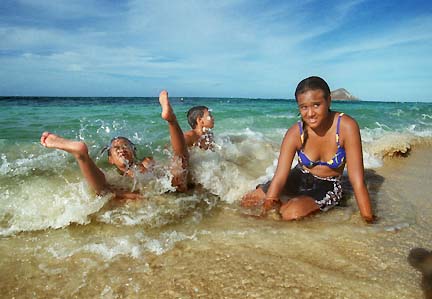Advertisement - Click to support our sponsors.

WAIMANALO CANOE CLUB
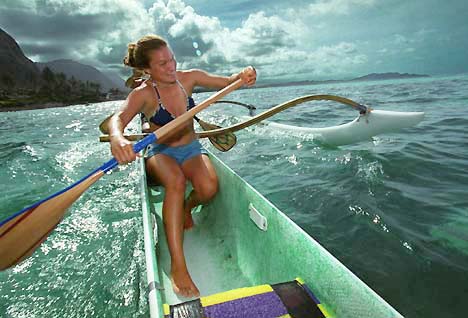
Turning the tide
Waimanalo rallies behind a
Story by Wilma Jandoc
positive program for its children
and keeps in touch with its
roots in the process
Photos by Dennis Oda
Star-BulletinNANI AKEO'S neighbor dealt drugs freely in her Waimanalo neighborhood. But it wasn't until one frightening night the winter of 1995 that she did something about it.
"He started doing it (drug dealing) right in front of my house," said Akeo, head custodian at the community's Pope Elementary School. "I kept asking him to stop."
When that got nowhere, she talked to the dealer's girlfriend and mother. The same night, while she was hanging Christmas lights outside her home, he came up to her and said to "mind her own f--ing business."
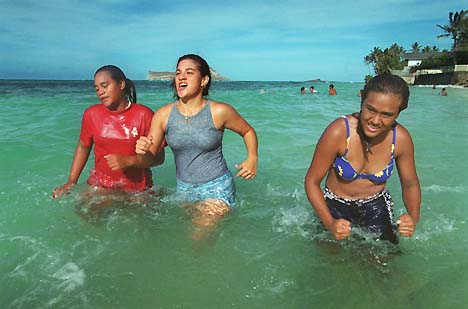
"I said right then and there that it is my business," she said.That began Akeo's sign campaign against drugs. She wrote messages like "Druggies not allowed" on poster paper and hung them on her fence.
But, said the 57-year-old mother and grandmother, "I knew I couldn't just preach. I wanted to give kids something else to do" besides falling prey to the fleeting high of doing drugs. As an avid outrigger canoe paddler for more than 20 years, Akeo thought that paddling would be a good alternative.
So she decided it was time to bring the Waimanalo Canoe Club home. Between 1985 and 1996 the club had been meeting and practicing in Kailua. But each year the club stayed 10 miles down the road from its namesake town, the fewer Waimanalo members it had.
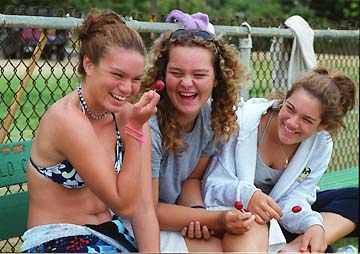
Club comes home
AKEO joined forces with her brother Joe Kaneakau, coaches Byron Wallwork and Nolan and Scottie Reis-Moniz to bring the club back to Waimanalo. No one may ever be able to "prove" that the dozens of Waimanalo youngsters who spend three or four days a week working out with their canoe club might otherwise have turned to drugs or crime. But when you see their enthusiasm for the sport and attachment to each other and their "auntie" and "uncle" coaches, it seems a reasonable bet that most are not taking that road now.Club membership has increased every year since it came back to Waimanalo. The club now has about 130 members, about 50 of whom are 15 years and under.
"The club keeps themselves very high-profile," said officer Barron Lee, Waimanalo area coordinator for community policing. He said Waimanalo rarely has incidents involving youth 14 or younger "in criminal activity, and no doubt the canoe club has been a help."
The club teaches kids safety, responsibility and discipline, coach Wallwork said. "We teach respect for the water, for each other," he said.
Kids, community involved
CLUB camaraderie and a love for the water are what keep 11-year-old Travis Hashimoto around long after practice ends at 4:30 p.m."We hang around, go swimming after practice and watch everyone else paddle," he said.
The club has brought kids out of their houses and into the water. "I used to stay home, do nothing, watch TV," said Kaiena Huihui, 13. Now she often stays hours after practice, talking and joking with other kids and coaches.
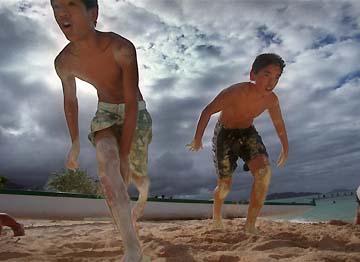
And the club has fostered cohesiveness within the community. Local fishermen cleaned up and improved Kaiona Beach at about the same time the club moved there. The fishermen watch over the kids when they're on the beach -- and the canoes when club members aren't around.Nolan Reis-Moniz said many Waimanalo residents volunteer when the club takes its turn hosting a regatta for other clubs in the Oahu Hawaiian Canoe Racing Association. They help with setting up booths, security and other jobs at the day-long race.
Parents have been especially active. David Thompson, whose daughter Maile has been in the canoe club for two years, often helps at the regattas and donates maile leis for races and blessings. "I'm cheerleader support," he said.
Thompson said the club has had a positive influence on his daughter. "I think with her interacting with more of the Hawaiian community than she has before, it's been a good balance," he said. "She's made a lot of good friends."
National exposure to come
THE club's success at pulling the community together and helping it get in touch with its Hawaiian roots is even going to get national recognition. The club will play a prominent part in a January 2001 National Geographic Magazine article about Waimanalo.The article will look at the links Hawaiians have to their culture, said Tom O'Neill, a senior writer for National Geographic.
"It's so inspiring," O'Neill said after spending the past week in Waimanalo. "I really love stories where people love their hometown."
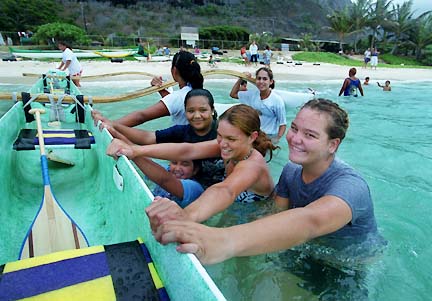
Akeo hopes more older teens will join the canoe club, which currently has no members between 16 and 19 years old."From about 14, that's the time they start going off and doing other stuff," she said.
And there are still troubled spots. Keaka Kealoha, 12, worries about a friend of his who quit the club some months ago. "I just found out he does drugs," Keaka said.
But there are success stories, too. There were some young drug addicts "who joined the club and decided to go into rehab," Akeo said. "They still keep in touch with me and tell me how the club helped them by forcing them to do something about it (their addiction)."
The paddling season will end for most of Waimanalo's six youth crews tomorrow, when OHCRA championships will be held at Keehi Lagoon.
But the lessons taught, the bonds formed, will go on as the club members and the community continue to help each other.
"You just gotta keep on going," Akeo said. "All the kids, everything just moves me to continue."
